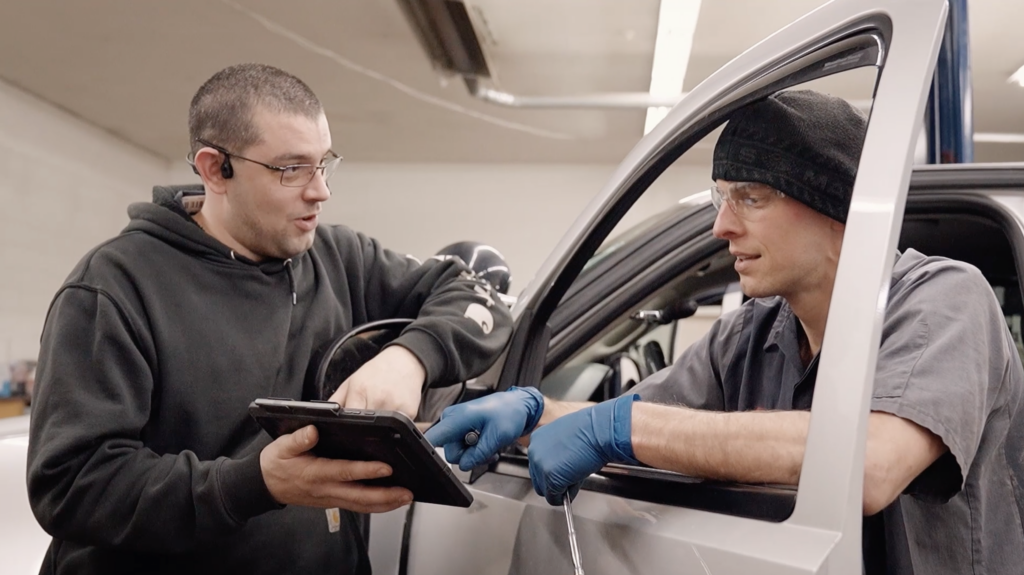
Whether conducted as a digital vehicle inspection or with paper and pen, vehicle inspections are a must-have in every auto shop’s workflow and should not be skipped.
Why your shop should do vehicle inspections
Vehicle inspections may seem mundane on the surface, but they are invaluable for a few reasons:
Consistent, Quality Work — Vehicle inspections help your technicians be thorough in finding what is (and isn’t) wrong with a vehicle. They also help your shop create a consistent process for how vehicles are evaluated — regardless of which technician is assigned.
Building Customer Trust — Inspections provide a transparent and detailed assessment of the customer’s vehicle condition. When customers can see exactly what issues or potential problems exist, it helps them understand their vehicle assessment, fosters a sense of honesty and openness, and helps them to feel like you are not trying to hide anything or recommend unnecessary repairs.
- Tip: Digital vehicle inspections are a great way to perform efficient inspections and provide the ability to easily add detailed notes, photos, and videos. When customers can view photos and videos to understand service recommendations, they are more likely to approve services and trust your shop. In 2023, AutoVitals, a leading provider of digital vehicle inspections, found a direct correlation between the amount of time a customer spends looking at their digital inspection and the value of the repair order: When a customer spends over 400 seconds looking through their digital inspection, they spend an additional $501 dollars on average compared to a customer who only looks at the inspection report for less than 200 seconds.
Liability Protection — Unfortunately, some shops find themselves in a pickle when a customer thinks the shop caused interior or exterior damage that was pre-existing. When you capture pre-existing damage in an inspection, you protect your shop in scenarios like this.
Building inspection templates
Not every job requires the same type of inspection, which is why we suggest you create different inspection templates that cover your bases for your most basic jobs to your most complex. For example, your “Safety Inspection” template will be different from your “Routine Maintenance Inspection” template, which will be different from your “Brake Inspection” template…and so on.
To make building your inspection templates easier, look for a shop management system with digital vehicle inspections or a provider like AutoVitals that offers pre-built inspection templates for you to choose from. While the initial set-up of multiple inspection templates may seem cumbersome, taking the time to set up your templates effectively and linking items to the appropriate canned jobs in your point of sale will drastically improve the efficiency of your estimating and invoicing process down the road.
To help you get started in facilitating consistent inspections, we’ve compiled a comprehensive list of common inspection items.
Comprehensive vehicle inspection checklist
Use this list to assist you in creating the various inspection checklist templates that will best fit your shop’s needs.
Note: Within the checklist, you will need a rating system. Many inspections use a “green, yellow, red” coding:
- Green = Checked and OK
- Yellow = May Require Future Attention
- Red = Requires Immediate Attention
Exterior inspection
- Body and Paint — Perform a visual inspection and note pre-existing dents, scratches, rust, and signs of accidents.
- Lights and Signals — Inspect the functioning of headlights, taillights, turn signals, brake lights, clearance lights, and license plate lights.
- Windshield and Windows — Look for cracks or chips.
- Side Mirrors — Check functionality.
- Windshield Wipers — Assess the condition for clear visibility.
- Tires and Wheels (see below)
Interior inspection
- Damage — Note pre-existing interior damage (rips or scratches on the upholstery, dash, etc.)
- Dashboard and Gauges — Ensure gauges and warning lights are working correctly.
- AC/Heating System — Verify proper functionality.
- Clutch (if applicable) — Check for proper functionality.
- Cabin Filter — Note if it needs replacement.
- Seatbelts — Check for functionality and damage.
Under the hood inspection
- Engine Fluids and Caps — Check engine oil, transmission fluid, coolant, brake fluid, and power steering fluid. Ensure caps are tightly sealed.
- Battery — Look for battery corrosion and secure connections.
- Belts, Hoses, and Lines: Look for signs of wear, cracks, leaks, and loose connections.
- Filters — Check oil, air, and fuel filters.
- Wiring – Check for damaged or loose wires.
- Spark Plugs – Look for wear and fouling.
- Engine Mounts — Inspect for wear or damage.
- Cooling Fans — Check for proper functionality.
- Brake Master Cylinder — Check for signs of leaks on all seals.
- Exhaust Manifold – Check for leaks.
- Leaks — Look for any signs of fluid leaks throughout.
Under the vehicle inspection
- Exhaust System — Check for leaks, rust, or damage.
- Suspension Components — Look for worn-out shocks, struts, or bushings.
- Frame and Chassis — Inspect for rust, cracks, and damage.
- Fuel Lines and Tank – Check for rust, damage, and secure attachment.
- Steering Components – Check linkage, tire rods, ball joints, rack and pinion, and steering gearbox for damage.
- Drive Belt — Inspect for signs of wear, cracking, or damage.
- Pullies — Check for worn bearings.
- Leaks — Look for signs of fluid leaks throughout.
- Bolts — Check for loose or missing bolts throughout.
- Tires and Wheels (see below)
- Brakes (see below)
Brake inspection
(This is a consolidated list of brake inspection items. You may see some repeat items from the lists above)
- Brake Fluid — Check fluid level and condition.
- Fluid Leaks — Look for brake fluid leaks around the master cylinder, brake lines, hoses, and calipers.
- Brake Pads — Inspect for wear and thickness.
- Rotors and Drums — Look for scoring, grooves, uneven wear, and warping.
- Calipers and Wheel Cylinders — Look for leaks or damage.
- Lines — Look for cracks, bulges, or signs of deterioration.
- Bolts and Clips — Ensure no bolts or clips are missing.
- Brake Pedal — Check for proper travel, firmness, and responsiveness. Listen for unusual noises.
- Booster — Check for vacuum leaks and proper operation.
- Parking Brake — Check for proper engagement, holding power, and ability to fully release.
Tire and wheel inspection
- Tire Pressure — Make sure they are at the right levels.
- Tread Depth — Measure for adequate tread depth.
- Tire Condition — Examine the tires for cuts, cracks, bulges, or any other visible damage on the sidewalls or the tread. Look for embedded objects.
- Tread Wear Patterns — Check for uneven wear patterns across the tire tread surface.
- Alignment — Check for proper wheel alignment.
- Balancing — Ensure tires are properly balanced.
- Lug Nuts — See if lug nuts are present, tightened to the recommended torque, and not loose or damaged.
- Tire Rotation — Note if they need rotations.
- Wheel Bearings and Hubs — Listen for unusual noises that may indicate wear.
- Spare Tire — Make sure it is in good condition, properly inflated, and has adequate tread depth.
Road test
- Engine Performance — Evaluate acceleration, power, and smoothness.
- Transmission — Ensure smooth and firm gear shifts and no slipping.
- Steering and Handling — Check for alignment issues or pulling to one side.
- Brakes — Test the responsiveness and effectiveness.
Remember, inspections are worth your shop’s time! Best of luck creating your shop’s inspection templates!



